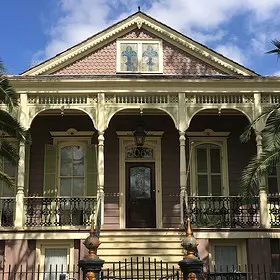Visit Historic New Orleans
Welcome to the Big Easy! New Orleans is a fabulous destination for history lovers, so here are 10 historic spots to visit (and explore and eat and imbibe) while you're in town.

photo by: A. J. Sisco
Volunteers hard at work preserving Chalmette National Cemetery.
Experience New Orleans' History
Chalmette National Cemetery
Established in 1864, Chalmette National Cemetery (a unit of the Jean Laffite National Historical Park and Preserve) is the final resting place for Union soldiers—including United States Colored Troops—who died in Louisiana during the Civil War. There are also more than 14,000 headstones that mark the graves of veterans of the Spanish-American War, World Wars I and II, and the Vietnam War.
Gallier Hall
This impressive structure, once the seat of city government, has 16 ballrooms, and as part of a two-year restoration—on track to be completed in time for the city’s tricentennial celebration in 2018—every one of them will look as good as new. Stop by to check out the progress, and learn more about James Gallier, the noted Irish architect whose designs give the city its unmistakable character.
Evergreen Plantation
As seen on the silver screen in films such as Django Unchained, this 250-year-old Louisiana plantation holds a cache of Southern history. In addition to being the only intact working antebellum sugar plantation in the South, Evergreen also offers the largest collection of extant slave dwellings in one place.
Saenger Theatre
New Orleans’ Saenger Theatre, located on historic Canal Street in the French Quarter, has been a beloved landmark since it opened as a movie palace in 1927. In 2005, Hurricane Katrina caused massive water damage to the Saenger’s interior, but after strong support from the local community—and an eight-year restoration—the building has been restored to its former glory.

photo by: Dan Silvers, Flickr
Carousel Bar & Lounge
Eat and Drink Your Way Through Crescent City
Carousel Bar & Lounge at the Hotel Monteleone
Located in the French Quarter, the Carousel Bar & Lounge at this Historic Hotel of America got its start in the 1940s, but found its true identity when they installed the rotating carousel bar in 1949. As the name suggests, this 25-seat rotating bar makes one rotation every 15 minutes ... just about the right amount of time to polish off a strong cocktail.
Rib Room at the Omni Royal Orleans
The Rib Room, which opened in 1961, offers a street-level fine dining experience for a weary traveler or for anyone seeking a bit of air conditioning and people-watching in the Quarter. While you're there, enjoy the ambience of the Omni Royal Orleans, another Historic Hotel of America.
Snake and Jake's Christmas Club Lounge
Celebrate Christmas early at this legendary dive bar. It's small, open late, and perfect for a visitor looking for a local watering hole with plenty of character. Bonus: Order a Seagram's drink to celebrate National Dive Bar Day on July 7, and find out how you can help support the National Trust!

photo by: Library of Congress
African House at Melrose Plantation
Take a Day Trip
African House at Melrose Plantation
This National Treasure, an enigmatic building located on the grounds of Melrose Plantation, is about 15 miles from Natchitoches, Louisiana, and part of the Cane River National Heritage Area. Melrose Plantation, a National Historic Landmark, is considered one of the finest examples of a Creole plantation in America. Taken together, they reflect the multi-faceted cultural identity of the Cane River area and the story of the many ways this unique culture has been preserved. Of particular note: the featured murals of African American folk artist Clementine Hunter, who lived, worked, and created her art here.
The Shadows
The Shadows, built as the home of a sugar planter, is situated on the banks of the Bayou Teche in the heart of Cajun Louisiana. In addition to interpreting the lives of the estate's residents and enslaved people, this National Trust Historic Site is currently exploring the life of William G. "Bunk" Johnson, a respected African American trumpeter skilled in New Orleans-style jazz who ultimately came to work at The Shadows and live in New Iberia.
Churches and Religious Sites in St. James Parish
St. James Parish, Louisiana, created in 1807, is made up of a scattering of small towns in a largely rural, agricultural area that straddles the Mississippi River midway between Baton Rouge and New Orleans, known to many as the heart of Cajun Country. The community takes great pride in its faith, and congregations over the centuries have made a concerted effort to preserve their churches.
Preservation Magazine: An Insider's Photo Tour of New Orleans

Check out some of our favorite snapshots of historic places from popular New Orleans Instagrammer, @the.preservationist.



